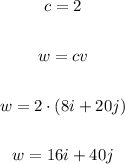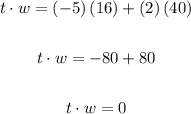ANSWER:
Part B:
w = 16i + 40j
Part C:
Orthogonal
Explanation:
Part b
We select a value of c, to determine the value of w, like this:

Part C
We can calculate the relationship between both vectors (t and w) using the dot product, like this:

When the dot product of two vectors is 0, the vectors form a right angle (90º) with each other. If the dot product of 2 vectors is zero, the vectors are perpendicular, that is, orthogonal.